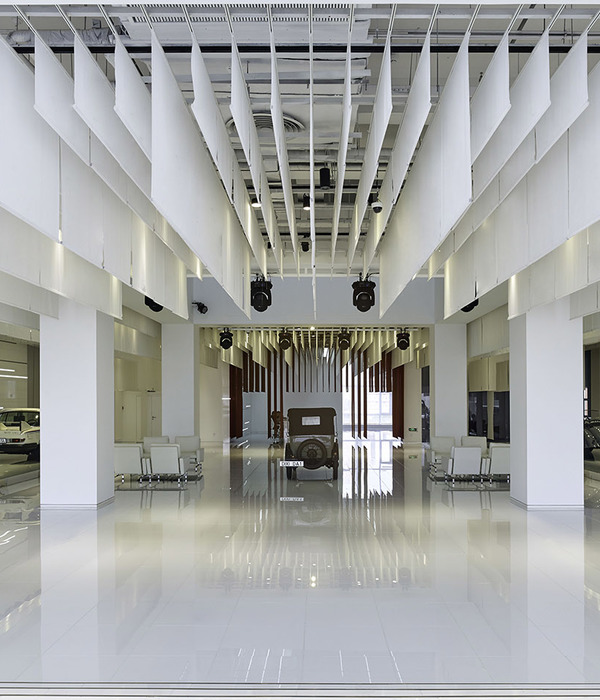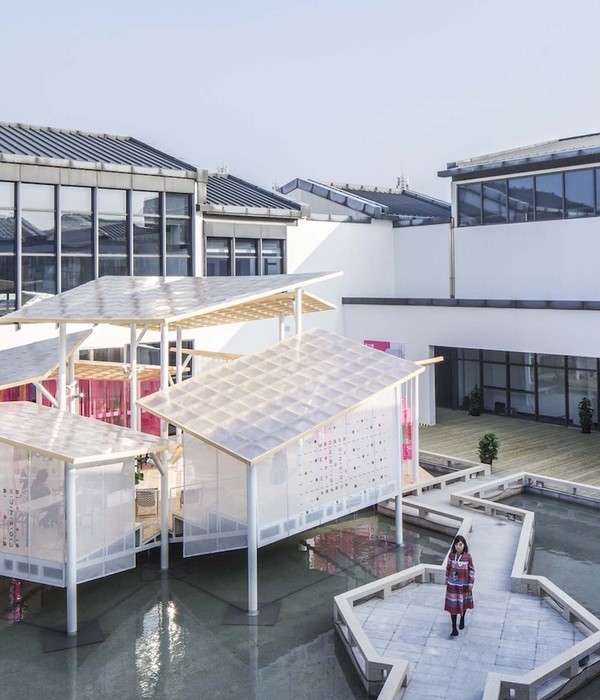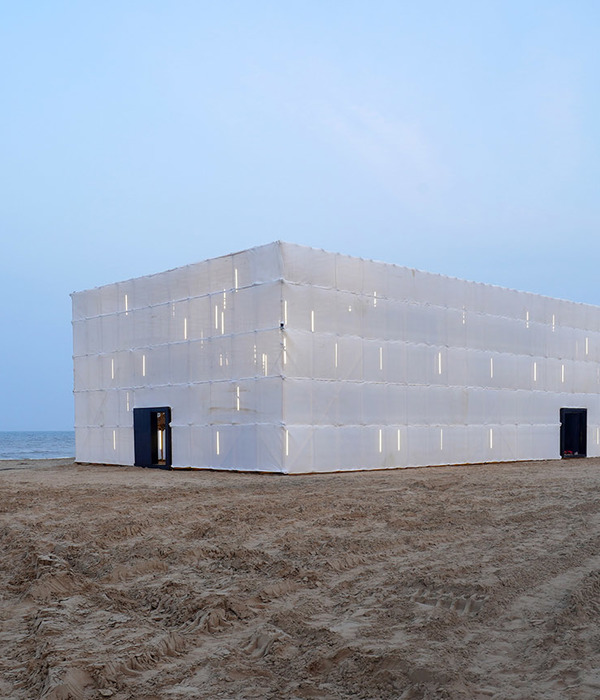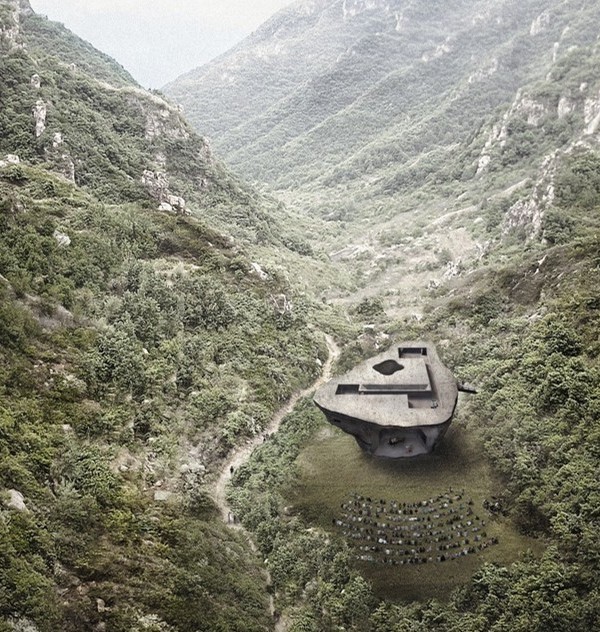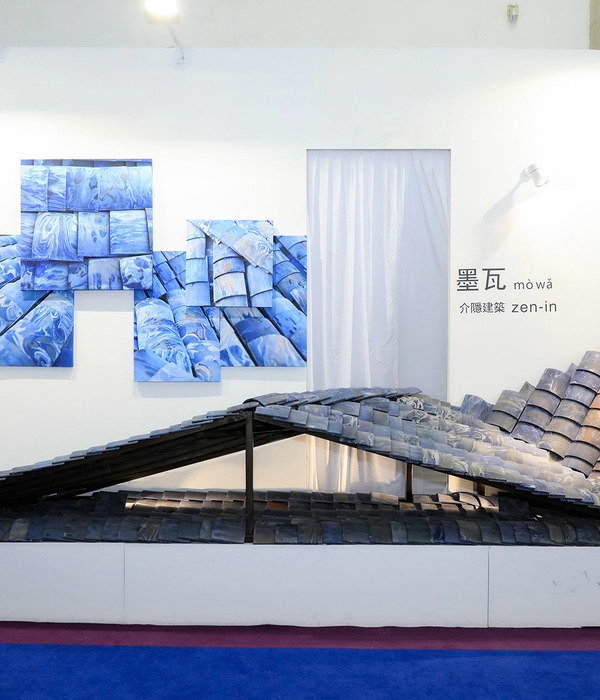Instead of planting indoor trees to combat insects, balconies and terraces around the periphery of the office zone were utilized for such vegetation, improving the interior landscape. The arrangement also creates an exterior image highly compatible with the surrounding urban landscape.
▼经过镜面处理的铝合金百叶天花板连接了内外空间,An aluminum louvered ceiling with a mirrored underside motif was designed to create a sense of continuity between interior and exterior spaces © Harunori Noda [Gankohsha]
In keeping with the theme of “openness,” an aluminum louvered ceiling with a mirrored underside motif was designed to create a sense of continuity between interior and exterior spaces. The black top and sides and electropolished underside create a surface that reflects the environment. Depending on the observer’s position and orientation, the exterior planted greenery, the interior space and the images of the bustling city seem to shift.
在“开放”的主题下,我们设计了一个底面经过镜面处理的铝合金百叶天花板,以连接内外空间。根据空间尺度将百叶剖面设定为宽50mm×高200mm、间距320mm,顶面和侧面为黒色,底面通过电解抛光处理形成可映出环境的表面。身处的位置和方向不同,所感受到的外构空间的植物、内部空间以及城市的繁华景象都会有所不同。
连接内外空间的无眩光镜面铝合金百叶天花板 Glare-free mirrored aluminum louver ceiling creates interior-exterior continuity
▼从建筑外部看露台,Terrace viewed from outside © yukikazu ito
▼露台绿化,Terrace with planting © yukikazu ito
出于防虫考虑,我们在办公区外围设置阳台和露台来种植植物代替室内直接栽种,在提升室内景观的同时,形成了与城市景观高度和谐的外观形象。
▼办公区域休息空间,Office communal area © yukikazu ito
▼室内细节,Interior details © yukikazu ito
Facility name: Zenyaku Kogyo Co., Ltd. R&D Center Location: Hachioji City, Tokyo Main use: Laboratory Client: Zenyaku Kogyo Co., Ltd. Concept design, schematic design, design development, construction supervision: Nikken Sekkei Ltd Site area: 16,733.31m2 Total floor area: 13,895.02m2 Number of floors: four above ground, one basement floor Maximum height:26.060 m Main structure: Steel-framed, part steel-framed reinforced concrete Construction period: July 2019 – February 2021 Construction: OBAYASHI CORPORATION
项目名称:全药工业株式会社研究开发中心 项目位置:东京都八王子市 主要用途:研究所 项目业主:全药工业株式会社 基本规划・基本设计・实施施计・监理:日建设计 用地面积:16,733.31 ㎡ 建筑面积:13,895.02 ㎡ 建筑层数:地上 4 层、地下 1 层 建筑高度:26.060 m 主体结构:钢结构、部分为钢骨钢筋混凝土结构 施工期间:2019 年 7 月~ 2021 年 2 月 施工单位:大林组
▼平面图,Plan © Nikken Sekkei Ltd
▼整体夜景,Overall view by night © Harunori Noda [Gankohsha]
▼建筑夜间局部外观,Exterior partial view by night © Harunori Noda [Gankohsha]
▼办公区域,Office area © yukikazu ito
▼入口区域,Entrance area © Harunori Noda [Gankohsha]
▼采光楼梯间,Stair well with skylight © Harunori Noda [Gankohsha]
In order to create a thoroughly mirrored surface, all obstructions were removed. The height of the equipment installed between the louvers was raised as high as possible above the underside, with downlights used to avoid scalloping and glare. The louvers were designed with a mountain-like 0.8mm shape so that downlight illumination would not be reflected on the sides of the louvers.
为了让底面成为完美的镜面,我们去除了阻碍成像的障碍物,尽可能地从百叶底部提高安装在百叶间的设备的安装高度,并采用了防止由筒灯引起扇形眩光的设计。具体而言,即通过操作筒灯的透镜挡板,以形成不会在百叶侧面投下扇形的配光曲线,同时把百叶侧面做成0.8mm的山形,避免筒灯的光源照射到百叶侧面。
▼场地鸟瞰,Site aerial view
通过线性分区打造舒适的工作场所 Creating a comfortable workplace through “linear zoning”
▼风景映射在开放空间的天花板上,The landscape’s ceiling reflection serving as an interface between the architecture and the city © yukikazu ito
▼从道路望向建筑和开放空间,View to the building and the open space from the road © Harunori Noda [Gankohsha]
The office and laboratory functions, which had been divided according to field of study, are now shared, resulting in a creative environment that transcends respective boundaries. The approach side of the site is set up as an open space with lush greenery, with the landscape’s ceiling reflection serving as an interface between the architecture and the city. The aim was to create a facility that “coexists” with the local community.
分别共享以往按照领域划分的办公功能和实验室功能,打造突破领域界限、具有创造性的环境。通过在地块的入口一侧设置绿意盎然的开放空间,将映射在天花板上的风景作为连接建筑与城市的界面,打造出与街区和谐共存的设施。
像把鱼剔成三片一般,我们将细长的建筑按平面清晰明快地划分为办公区、实验室区和设备管井区,形成了三个不同用途的细长分区。由此,得到了进深较浅且靠近外部环境的办公区,以及靠近设备管井且高度灵活的实验室区。
Mindful of this, an attempt here was made to convert the existing “closed/isolated” building type to a “closed lab/open institute” type of structure. Although the term “open” is used rather loosely in the architecture industry, the conception held that it would carry great meaning pertinent to the building type of a laboratory.
In recent years, the research environment has become an increasingly diverse landscape, showing growth in collaborations with outside companies such as open labs, cooperative efforts with venture companies, and the outsourcing of research work. More than ever, higher performance and quality environments are required of labs, making it extremely important for research institutes to make connections beyond previous boundaries and with other researchers.
因此,我们在设计中尝试将现有的“封闭整个地块”的传统建筑形式转换为“封闭实验室部分,开放整个研究所”的形式。“开放”作为建筑主题虽已司空见惯,但我们认为在研究所这一建筑类型中具有重要意义。
近年来,研究环境呈现多样化趋势,比如像开放实验室一样与外部企业或风险投资公司进行合作研究,或将部分研究工作外包等。在此背景下,对实验室的性能和环境的要求比以往更高,研究所与外部的联系以及研究人员之间的联系变得极为重要。
▼项目外观,Exterior view © Harunori Noda [Gankohsha]
This project was for the relocation and construction of a new research & development center for Japanese pharmaceutical company Zenyaku Kogyo Co., Ltd., which celebrated its 70th anniversary in 2020.
▼大楼梯,The grand staircase © Harunori Noda [Gankohsha]
The office zone, on the other hand, was designed to be a single, shared space that facilitates communication between researchers. By locating the office zone on the north side of the Keio Line, a view of the city featuring the rich landscape along the railway, as well as stable north side illumination, was ensured.
另一方面,将办公区规划成一个不将研究领域分隔的一体化共享空间,以便于研究人员之间进行交流。通过在京王线沿线北侧设置办公区,从而确保了良好的视野、京王线沿线的丰富景观以及北侧稳定的采光。
▼公共区域,Communal area © Harunori Noda [Gankohsha]
▼实验室区域,Laboratory area © Harunori Noda [Gankohsha]
日本制药公司全药工业株式会社在2020年迎来了创立70周年,本项目是对其研发基地的搬迁新建设计。
▼中庭,Atrium © Harunori Noda [Gankohsha]
The building span of 6.4m at the laboratory zone is determined by the dimensions of the lab benches, and in consideration of future flexibility for maintenance and upgrading. Given that individual fields require varying levels of airtightness, sound insulation, cleanliness and temperature stability, labs have then been “stacked” across multiple levels by research field.
Zones for offices, the laboratory and the equipment shafts are clearly delineated in the long, narrow building. This has resulted in a relatively “shallow” office zone area near in proximity to the external environment, and a lab zone close to equipment shafts that offers a high degree of flexibility.
▼剖面图,Section © Nikken Sekkei Ltd
由于每个研究领域所需的气密性、隔音性、清洁度和温度稳定性各有不同,加之考虑到将来诸如维修性、更新性的灵活度,在设计实验室区时,我们根据实验台的尺寸确定建筑跨度,并按照研究领域进行堆叠。
{{item.text_origin}}


